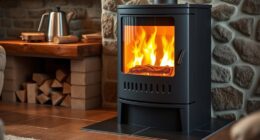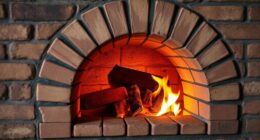We’ve all been there – that frustrating moment when the stove isn’t heating up properly and dinner is on the line. But fear not, because in this article, we’re going to show you the ins and outs of replacing stove gaskets.
From understanding the signs of worn out gaskets to the step-by-step process of installation, we’ve got you covered.
So grab your tools and let’s get those gaskets replaced, ensuring efficient cooking for many meals to come.
Key Takeaways
- Signs of worn out stove gaskets include visible damage, irregularities or gaps, increased heat escaping, and difficulty in maintaining a consistent temperature.
- Worn-out stove gaskets can compromise efficiency and pose potential safety risks by allowing heat and gas to escape.
- Regularly inspecting and replacing worn-out gaskets can maximize energy efficiency and reduce the carbon footprint.
- When replacing stove gaskets, consider the choice of materials, such as silicone, fiberglass, or graphite, based on temperature, pressure, and chemical resistance.
Signs of Worn Out Stove Gaskets
We’ve noticed that our stove gaskets are starting to show signs of wear and tear. It’s important to keep an eye on the condition of your stove gaskets, as they play a crucial role in maintaining a proper seal and preventing heat loss. When gaskets start to deteriorate, they can compromise the efficiency of your stove and even pose safety risks.
To determine if your stove gaskets need replacement, inspect them for any visible damage such as fraying, cracking, or crumbling. Run your fingers along the gasket to feel for any irregularities or gaps. Additionally, if you notice increased heat escaping from the stove or difficulty in maintaining a consistent temperature, it could be a sign that the gaskets are no longer functioning optimally.
When it comes to replacing stove gaskets, there are several techniques you can employ. One option is to hire a professional to do the job for you. They’ve the expertise and specialized tools to ensure a proper installation. However, if you prefer a more cost-effective approach, there are DIY gasket repair methods available. These methods usually involve purchasing replacement gasket material and following step-by-step instructions provided by the manufacturer.
Understanding the Importance of Stove Gaskets
Understanding the importance of stove gaskets is crucial in maintaining the optimal functioning of your stove.
The gaskets act as a seal between the stove door and the body, preventing heat and gas from escaping.
This not only ensures energy efficiency but also enhances safety by minimizing the risk of gas leaks or accidental burns.
Gasket Lifespan and Signs
Our gasket experts recommend regularly checking for signs of wear and tear, such as cracks or leaks, to determine if it’s time to replace your stove gaskets.
Stove gaskets play a crucial role in maintaining the efficiency and safety of your appliance. Over time, these gaskets can deteriorate due to exposure to heat, moisture, and constant use. As a result, they may fail to create an airtight seal, leading to energy loss and potential safety hazards.
When it comes to gasket replacement cost, it can vary depending on the type and brand of gasket you need. To find reliable gasket suppliers, it’s recommended to research online or check with local appliance repair stores. Comparing prices and considering customer reviews can help you make an informed decision and ensure you get high-quality gaskets at a reasonable price.
Impact on Energy Efficiency
As homeowners, we can improve the energy efficiency of our appliances by regularly inspecting and replacing worn-out gaskets. When it comes to stove gaskets, this simple maintenance task can have a significant impact on energy efficiency. Here are three techniques for improving energy efficiency through gasket replacement:
-
Choose energy efficient materials: Opt for gaskets made from high-quality materials like silicone or fiberglass. These materials offer better insulation, reducing heat loss and improving stove efficiency.
-
Proper installation: Ensure the gasket is installed correctly, creating an airtight seal. This prevents heat from escaping and keeps your stove running efficiently.
-
Regular inspection and replacement: Inspect your stove gasket regularly for signs of wear and tear. If you notice fraying, cracking, or gaps, it’s time to replace the gasket. Regular replacement ensures optimal energy efficiency.
By following these techniques and choosing energy efficient materials, we can maximize the energy efficiency of our stoves and reduce our carbon footprint.
Now let’s explore the next section: ‘diy vs. professional’ to determine the best approach for replacing stove gaskets.
DIY Vs. Professional
When it comes to replacing stove gaskets, we may be wondering whether it’s best to tackle the task ourselves or hire a professional. Let’s compare the DIY approach with hiring a professional in terms of cost. Here is a cost comparison table:
| DIY Approach | Professional |
|---|---|
| Cost of gasket material | Cost of hiring a professional |
| Time spent on research and installation | Expertise and experience |
| Potential mistakes and additional expenses | Guaranteed workmanship and warranty |
Choosing the DIY approach may seem cost-effective initially, but it requires time and effort to research and install the gasket correctly. There is also the risk of making mistakes and incurring additional expenses. On the other hand, hiring a professional ensures expert installation, saving you time and potential errors. Additionally, professionals offer guaranteed workmanship and warranties, providing peace of mind. Consider your skill level, time availability, and budget when deciding between DIY and hiring a professional for stove gasket replacement.
Tools and Materials Needed for Replacing Stove Gaskets
To successfully replace stove gaskets, we must ensure we have the essential tools and materials at our disposal.
The tools required include a screwdriver, pliers, and a putty knife for removing the old gasket and installing the new one.
Additionally, it’s crucial to choose the right materials, such as high-temperature adhesive and a gasket kit specifically designed for stove use, to ensure a proper and long-lasting seal.
Essential Tools for Gaskets
We’ll need a few essential tools for replacing stove gaskets. Here are three key tools that are necessary for a successful gasket replacement:
-
Gasket Material: Choosing the right gasket material is crucial. It should be heat-resistant and durable to withstand the high temperatures generated by the stove. Silicone, fiberglass, and graphite are commonly used gasket materials due to their excellent heat resistance properties.
-
Adhesive: Proper gasket installation requires a high-temperature adhesive. This adhesive ensures that the gasket sticks firmly to the stove surface and prevents any leaks. Look for an adhesive specifically designed for stove gaskets to ensure a secure and long-lasting bond.
-
Gasket Installation Tool: A gasket installation tool, such as a gasket roller or a gasket press, is essential for achieving a uniform and tight seal. This tool helps in evenly compressing the gasket and ensures a proper fit around the stove door or other areas that require gasket replacement.
Choosing the Right Materials
Silicone, fiberglass, and graphite are commonly used materials for stove gaskets due to their excellent heat resistance properties. When choosing a gasket material, it’s important to consider factors such as temperature, pressure, and chemical resistance.
Silicone gaskets are known for their flexibility and ability to withstand high temperatures up to 600°F. Fiberglass gaskets, on the other hand, offer exceptional thermal insulation and are suitable for temperatures up to 1000°F. Graphite gaskets are highly resilient and can handle extreme temperatures up to 1800°F.
When comparing different gasket materials, it’s crucial to consider the specific requirements of the stove, such as the level of heat exposure and the presence of corrosive substances. Additionally, selecting the appropriate gasket thickness is vital to ensure a proper seal and prevent heat loss or leakage.
Overall, careful consideration of gasket materials and thickness will ensure optimal performance and longevity of the stove gasket system.
Safety Precautions Before Replacing Stove Gaskets
Before we begin replacing stove gaskets, it’s important to ensure our safety by taking necessary precautions. Here are some key steps to follow for a safe and successful gasket replacement:
-
Turn off the power: Always disconnect the power supply to the stove before starting any work. This will prevent any potential electrical accidents and ensure your safety.
-
Wear protective gear: It’s crucial to wear proper protective gear such as gloves and safety goggles. Gaskets can be made of materials that may cause irritation or allergic reactions, so protecting yourself is essential.
-
Proper ventilation: Ensure there’s adequate ventilation in the area where you’ll be working. Open windows or use fans to circulate fresh air and remove any fumes or odors that may be released during the replacement process.
Proper installation of stove gaskets is equally important for the safety and performance of your stove. A well-installed gasket will create an airtight seal, preventing heat and gas leaks. Follow the manufacturer’s instructions carefully and use the correct adhesive or fasteners to secure the gasket in place. Improper installation can lead to energy inefficiency, decreased performance, and potential safety hazards.
Step-by-Step Guide to Removing Old Stove Gaskets
Removing the old gaskets is an important step in the process of replacing the stove’s seal for optimal performance. Before we dive into the step-by-step guide, it’s crucial to understand the importance of choosing the right gasket material and cleaning the stove surface properly.
When it comes to choosing gasket materials, it’s essential to consider factors such as heat resistance, durability, and compatibility with your stove model. Common materials used for stove gaskets include fiberglass, ceramic, and graphite. Fiberglass gaskets are cost-effective and offer good heat resistance, while ceramic gaskets provide excellent durability and heat retention. Graphite gaskets are known for their high-temperature resistance and flexibility.
Once you’ve chosen the appropriate gasket material, it’s time to remove the old gaskets. Follow these steps carefully:
- Turn off the stove and allow it to cool completely.
- Open the stove door and locate the gasket around the door frame.
- Use a gasket scraper or a putty knife to gently remove the old gasket. Be cautious not to damage the stove surface.
- Clean the stove surface using a mild detergent or stove cleaner to remove any residue or adhesive.
- Wipe the surface dry and ensure it’s completely clean before proceeding with installing the new gasket.
Cleaning and Preparing the Stove Surface
Now that we’ve successfully removed the old stove gaskets, it’s crucial to clean and prepare the stove surface before installing the new ones. This step is essential to ensure proper adhesion and prevent gasket damage.
Here are the cleaning techniques we recommend for preparing the stove surface:
-
Use a mild detergent: Mix a small amount of mild detergent with warm water. Dip a soft cloth or sponge into the solution and gently scrub the stove surface. This will help remove any grease, dirt, or residue that may hinder the gasket’s adhesion.
-
Avoid abrasive cleaners: Abrasive cleaners can scratch the stove surface and damage the gasket. It’s important to avoid using any harsh chemicals or abrasive materials during the cleaning process.
-
Thoroughly dry the surface: After cleaning, make sure to dry the stove surface completely using a clean, dry cloth. Moisture can affect the gasket’s adhesion, so it’s crucial to ensure a dry and clean surface before proceeding with the installation.
Choosing the Right Replacement Stove Gaskets
When it comes to choosing the right replacement stove gaskets, we must consider the material options and ensure we find the correct size.
The material options for gaskets include fiberglass, rope, and graphite, each with its own benefits and drawbacks.
Additionally, finding the correct size is crucial for a proper seal and optimal stove performance.
Material Options for Gaskets
We should consider the different material options for gaskets before making a decision. When it comes to stove gaskets, there are several materials to choose from, each with its own pros and cons. Here are three common options:
-
Silicone: This material is known for its excellent heat resistance and durability. It can withstand high temperatures without losing its elasticity, making it ideal for stove gaskets. However, silicone gaskets tend to be more expensive than other materials.
-
Fiberglass: Fiberglass gaskets are popular because of their affordability and good thermal insulation properties. They can handle high temperatures and provide a tight seal. However, fiberglass gaskets may wear out faster than other materials and can release small particles that may irritate the skin and lungs.
-
Graphite: Graphite gaskets are highly resistant to extreme temperatures and chemicals, making them suitable for demanding stove applications. They also have excellent anti-stick properties. However, graphite gaskets can be brittle and prone to cracking over time.
Consider these pros and cons when choosing the right material for your stove gaskets.
Finding the Correct Size
After considering the pros and cons of different materials, it’s important to find the correct size for our gaskets. When it comes to finding gasket suppliers, we must ensure that they offer a wide range of sizes to fit our specific needs.
To measure gasket dimensions accurately, we need to follow a precise procedure. Firstly, we must measure the inner diameter of the stove door or flue pipe where the gasket will be installed. This measurement will determine the required outer diameter of the gasket. Additionally, we need to measure the thickness of the gasket required for proper sealing.
Installing New Stove Gaskets: Tips and Tricks
One of our best tips for installing new stove gaskets is to apply a thin layer of high-temperature adhesive before placing them in position. This ensures a secure and long-lasting seal, preventing any air or heat leakage.
Here are some additional tips and tricks for proper gasket installation:
-
Choosing gasket materials: When selecting gasket materials, it’s crucial to consider the temperature range and compatibility with your stove. Common materials include fiberglass, silicone, and graphite. Fiberglass gaskets are suitable for moderate temperatures, while silicone and graphite gaskets can withstand high heat.
-
Clean and prepare the surface: Before installing the new gasket, make sure to thoroughly clean the surface where it will be attached. Remove any old adhesive residue or debris to ensure proper adhesion.
-
Apply the adhesive evenly: Using a small brush or spatula, apply a thin layer of high-temperature adhesive to both the stove surface and the gasket. Be careful not to apply too much adhesive, as it can cause excess buildup and poor sealing.
Securing the Gaskets for a Proper Seal
To ensure a proper seal, it’s important to securely attach the gaskets by applying a thin layer of high-temperature adhesive. Proper installation of stove gaskets is crucial for the efficient functioning of your stove. Here are some troubleshooting techniques that will help you secure the gaskets effectively:
-
Inspect the Gaskets: Before installation, carefully examine the gaskets for any signs of wear or damage. Replace any worn-out gaskets to ensure a proper seal.
-
Clean the Surface: Thoroughly clean the surface where the gaskets will be attached. Remove any dirt, grease, or old adhesive residue. A clean surface will promote better adhesion.
-
Apply Adhesive: Apply a thin layer of high-temperature adhesive to the gasket and the surface. Use a brush or a spatula to spread the adhesive evenly. Make sure to cover the entire surface area.
-
Securely Attach the Gaskets: Press the gaskets firmly onto the surface, ensuring they’re properly aligned. Apply gentle pressure to ensure a strong bond between the gasket and the surface.
By following these steps, you can ensure a proper seal and prevent any leaks or inefficiencies. Once the gaskets are securely attached, it’s time to test their efficiency.
[Transition sentence: In the next section, we’ll discuss how to test the new stove gaskets for efficiency.]Testing the New Stove Gaskets for Efficiency
In order to determine the effectiveness of our newly installed gaskets, we’ll conduct a series of tests to assess their efficiency. It’s crucial to ensure that the gaskets are reliable and durable, as they play a vital role in maintaining the proper seal of the stove.
Here are the testing methods we’ll employ to evaluate the gasket durability:
-
Compression Testing: We’ll subject the gaskets to varying degrees of pressure to simulate real-world conditions. This will help us determine how well the gaskets withstand compression and maintain their shape over time.
-
Temperature Testing: The gaskets will be exposed to high temperatures to assess their resistance to heat. By subjecting them to extreme heat, we can observe how well they retain their elasticity and sealing properties.
-
Chemical Resistance Testing: We’ll expose the gaskets to different chemicals commonly found in kitchens, such as oils, cleaners, and solvents. This will allow us to evaluate their resistance to chemical degradation and ensure that they remain intact and effective in the long run.
Maintaining and Extending the Lifespan of Stove Gaskets
To ensure the longevity of our gaskets, we regularly clean and lubricate them as part of our routine maintenance. Gasket maintenance is essential to prevent leaks and ensure the proper functioning of our stoves.
When it comes to gasket replacement techniques, it’s important to follow a systematic approach to ensure a successful and efficient replacement process.
Firstly, before replacing a gasket, it’s crucial to inspect it thoroughly. Look for any signs of wear and tear, such as cracks, fraying, or compression loss. If any of these issues are present, it’s time to replace the gasket.
When removing the old gasket, it’s important to be gentle and avoid damaging the surrounding components. Use a scraper or a putty knife to carefully remove the old gasket residue. Make sure to clean the surface thoroughly before installing the new gasket.
Next, choose the appropriate gasket material for your stove. There are various types of gaskets available, such as fiberglass rope, graphite impregnated rope, or silicone gaskets. Select the one that best suits your stove’s requirements.
During the installation process, ensure that the gasket is properly aligned and evenly distributed along the seal. Apply a high-temperature adhesive to secure the gasket in place. Allow sufficient time for the adhesive to dry before using the stove.
Regular gasket maintenance and proper replacement techniques are vital to extend the lifespan of our stove gaskets and ensure optimal performance. By following these guidelines, we can minimize the risk of leaks and maintain the efficiency of our stoves.
Common Mistakes to Avoid When Replacing Stove Gaskets
When it comes to replacing stove gaskets, there are a few common mistakes that are important to avoid. These mistakes can lead to inefficient stove performance and potential safety hazards. To ensure a successful replacement, here are some troubleshooting tips to keep in mind:
-
Incorrect measurement: One of the most common mistakes isn’t measuring the gasket correctly. It’s crucial to measure the length and thickness accurately to ensure a proper fit. Using the wrong size gasket can result in leakage and decreased efficiency.
-
Improper installation: Another mistake to avoid is improper installation. It’s essential to follow the manufacturer’s instructions carefully. Failing to install the gasket correctly can lead to gaps, allowing heat to escape and potentially causing damage to the stove.
-
Neglecting regular maintenance: Many people make the mistake of neglecting regular maintenance of stove gaskets. Over time, gaskets can wear out or become damaged, affecting the stove’s performance. It’s important to inspect and replace gaskets as needed to maintain optimal efficiency.
Troubleshooting Stove Gasket Issues
Our troubleshooting process for stove gasket issues starts with carefully inspecting the gasket for any signs of wear or damage. When diagnosing gasket problems, it’s crucial to pay close attention to the condition of the gasket. We examine it for any tears, cracks, or deformities that could compromise its effectiveness. Additionally, we check for any gaps between the gasket and the stove door or frame, as this can also contribute to issues.
If we identify any wear or damage, we recommend replacing the gasket as soon as possible. A faulty gasket can lead to heat loss, reduced energy efficiency, and potential safety hazards. To troubleshoot gasket issues, we also consider the age of the gasket. Over time, gaskets can become less flexible and lose their ability to create an airtight seal. If the gasket is older and showing signs of deterioration, replacement is often the best solution.
Another aspect of troubleshooting gasket issues involves checking the gasket’s alignment. Sometimes, the gasket may become misaligned or dislodged, causing it to no longer provide a proper seal. In such cases, we carefully readjust the gasket to ensure it’s properly aligned with the stove door or frame.
Frequently Asked Questions
How Often Should Stove Gaskets Be Replaced?
When is the best time to replace stove gaskets? How do we choose the right type of gasket for our stove? These are important questions to consider when maintaining our stoves.
Regularly inspecting and replacing gaskets is crucial to ensure optimal performance and energy efficiency. Over time, gaskets can become brittle and lose their effectiveness, leading to heat loss and potential safety hazards. It’s recommended to replace stove gaskets every 1-2 years or as soon as signs of wear and tear are noticed.
When selecting a gasket, consider the type of stove and its specific requirements for heat resistance and sealing capability.
Can I Use Any Type of Gasket for My Stove?
Using silicone gaskets for stoves has numerous benefits. High quality gaskets provide excellent heat resistance, ensuring that your stove operates efficiently. They also offer excellent sealing capabilities, preventing any leaks or drafts.
When it comes to replacing stove gaskets, it’s important to use the appropriate type for your stove. Different stoves may require different types of gaskets based on their specific design and requirements. Therefore, it’s recommended to consult the manufacturer’s guidelines or seek professional advice to ensure the correct gasket is used for your stove.
Is It Necessary to Clean the Stove Surface Before Installing New Gaskets?
When replacing stove gaskets, it’s essential to clean the stove surface before installation. Cleaning the surface ensures proper adhesion and prevents any debris or residue from interfering with the gasket’s effectiveness. By cleaning the stove surface, we eliminate any potential contaminants that could compromise the seal.
This cleaning process is crucial to maintain the efficiency and safety of the stove. It’s necessary to give due attention to the benefits of cleaning and follow the recommended steps for a successful gasket replacement.
What Should I Do if the New Gaskets Are Not Sealing Properly?
If the new gaskets aren’t sealing properly, troubleshooting the gasket installation is essential.
Firstly, check if the gaskets have been installed correctly, ensuring they’re aligned properly and securely fastened.
If the issue persists, alternative solutions for sealing issues can be explored, such as using high-temperature silicone sealant or adhesive tape designed for stove gaskets.
It’s important to consult the stove manufacturer’s guidelines and seek professional assistance if needed.
Are There Any Maintenance Tasks I Can Perform to Extend the Lifespan of My Stove Gaskets?
When it comes to extending the lifespan of our stove gaskets, there are some maintenance tasks we can perform.
By regularly cleaning and inspecting the gaskets, we can prevent common problems such as wear and tear, leaks, and improper sealing.
Additionally, lubricating the gaskets with a recommended product can help maintain their flexibility and effectiveness.
Following these maintenance tips will help ensure that our stove gaskets last longer and perform their sealing function efficiently.
Conclusion
In conclusion, regularly replacing worn out stove gaskets is crucial for maintaining the efficiency and safety of your stove.
By following the step-by-step guide and taking necessary safety precautions, you can easily remove old gaskets and install new ones.
Remember, ‘An ounce of prevention is worth a pound of cure,’ so make sure to maintain and extend the lifespan of your stove gaskets to avoid any unnecessary issues in the future.





